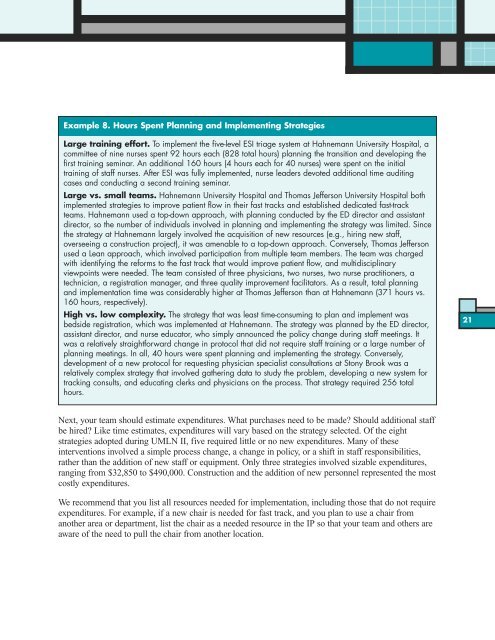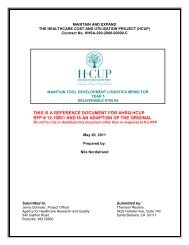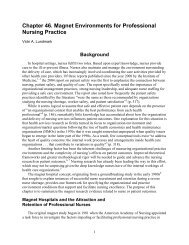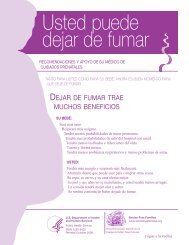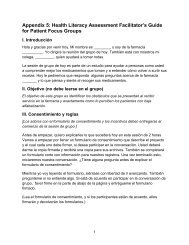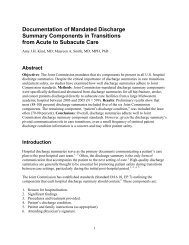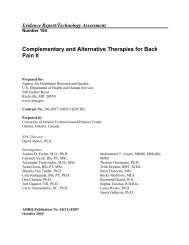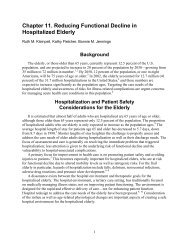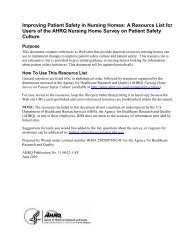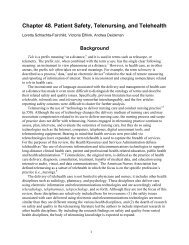Improving Patient Flow and Reducing Emergency Department ...
Improving Patient Flow and Reducing Emergency Department ...
Improving Patient Flow and Reducing Emergency Department ...
You also want an ePaper? Increase the reach of your titles
YUMPU automatically turns print PDFs into web optimized ePapers that Google loves.
Example 8. Hours Spent Planning <strong>and</strong> Implementing Strategies<br />
Large training effort. To implement the five-level ESI triage system at Hahnemann University Hospital, a<br />
committee of nine nurses spent 92 hours each (828 total hours) planning the transition <strong>and</strong> developing the<br />
first training seminar. An additional 160 hours (4 hours each for 40 nurses) were spent on the initial<br />
training of staff nurses. After ESI was fully implemented, nurse leaders devoted additional time auditing<br />
cases <strong>and</strong> conducting a second training seminar.<br />
Large vs. small teams. Hahnemann University Hospital <strong>and</strong> Thomas Jefferson University Hospital both<br />
implemented strategies to improve patient flow in their fast tracks <strong>and</strong> established dedicated fast-track<br />
teams. Hahnemann used a top-down approach, with planning conducted by the ED director <strong>and</strong> assistant<br />
director, so the number of individuals involved in planning <strong>and</strong> implementing the strategy was limited. Since<br />
the strategy at Hahnemann largely involved the acquisition of new resources (e.g., hiring new staff,<br />
overseeing a construction project), it was amenable to a top-down approach. Conversely, Thomas Jefferson<br />
used a Lean approach, which involved participation from multiple team members. The team was charged<br />
with identifying the reforms to the fast track that would improve patient flow, <strong>and</strong> multidisciplinary<br />
viewpoints were needed. The team consisted of three physicians, two nurses, two nurse practitioners, a<br />
technician, a registration manager, <strong>and</strong> three quality improvement facilitators. As a result, total planning<br />
<strong>and</strong> implementation time was considerably higher at Thomas Jefferson than at Hahnemann (371 hours vs.<br />
160 hours, respectively).<br />
High vs. low complexity. The strategy that was least time-consuming to plan <strong>and</strong> implement was<br />
bedside registration, which was implemented at Hahnemann. The strategy was planned by the ED director,<br />
assistant director, <strong>and</strong> nurse educator, who simply announced the policy change during staff meetings. It<br />
was a relatively straightforward change in protocol that did not require staff training or a large number of<br />
planning meetings. In all, 40 hours were spent planning <strong>and</strong> implementing the strategy. Conversely,<br />
development of a new protocol for requesting physician specialist consultations at Stony Brook was a<br />
relatively complex strategy that involved gathering data to study the problem, developing a new system for<br />
tracking consults, <strong>and</strong> educating clerks <strong>and</strong> physicians on the process. That strategy required 256 total<br />
hours.<br />
Next, your team should estimate expenditures. What purchases need to be made? Should additional staff<br />
be hired? Like time estimates, expenditures will vary based on the strategy selected. Of the eight<br />
strategies adopted during UMLN II, five required little or no new expenditures. Many of these<br />
interventions involved a simple process change, a change in policy, or a shift in staff responsibilities,<br />
rather than the addition of new staff or equipment. Only three strategies involved sizable expenditures,<br />
ranging from $32,850 to $490,000. Construction <strong>and</strong> the addition of new personnel represented the most<br />
costly expenditures.<br />
We recommend that you list all resources needed for implementation, including those that do not require<br />
expenditures. For example, if a new chair is needed for fast track, <strong>and</strong> you plan to use a chair from<br />
another area or department, list the chair as a needed resource in the IP so that your team <strong>and</strong> others are<br />
aware of the need to pull the chair from another location.<br />
21


